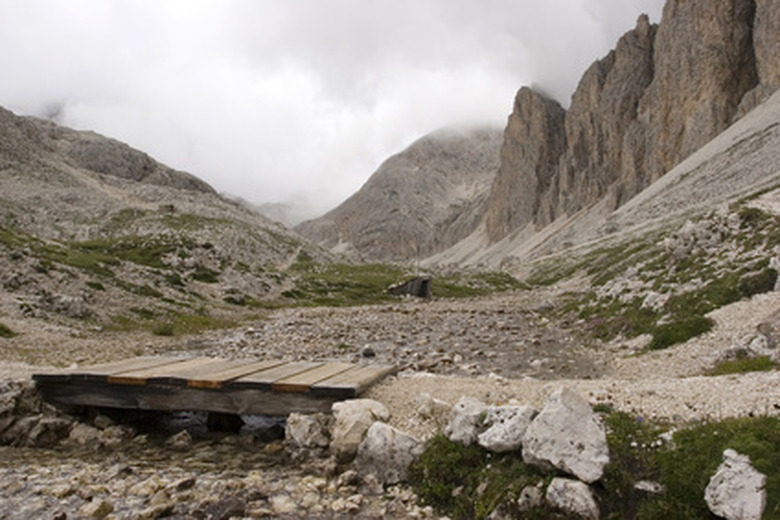What Forces Cause Weathering & Erosion?
Weathering and erosion are related processes, but they are not the same. Weathering is the breakdown of earthen materials like soil or rock, and erosion is a geological process where those materials are worn away and then also transported by forces like wind or water. There are both man-made and natural causes of weathering and erosion.
Physical Weathering
Physical Weathering
Physical weathering, also known as mechanical weathering, is when rain, wind or other atmospheric conditions cause rocks to crumble. Water is a key agent of physical weathering either in its liquid or frozen forms. Water can seep into cracks, and when the temperature drops, the water will freeze. Since water expands as it freezes, this creates an ice wedge that slowly cracks and splits the rock. Tiny rock fragments are carried away as the ice melts, and this entire cycle is called frost weathering, or cryofracturing.
Temperature can also cause thermal stress in rocks. As the temperature increases, rocks expand, and as the temperature cools, they contract. Over a long period of time, this leads to the structure of the rock weakening, and it crumbles. Rocky desert landscapes are especially vulnerable to this process because of the high daytime temperatures and low nighttime temperatures.
Chemical Weathering
Chemical Weathering
Chemical weathering changes the molecular structure of soil and rocks. When carbon dioxide from the air or soil combines with water, it's called carbonation. A weak acid, carbonic acid, forms and can dissolve limestone underground. Over a long period of time, it can open huge cracks or hollow out networks of caves. When large portions of limestone on the Earth's surface are dissolved through this process, the landscape becomes karst. Karst landscapes are pocketed with sinkholes and caves.
Oxidation is another form of chemical weathering where rocks that contain iron turn to rust. As the rust expands, it weakens rock and helps break it apart.
Water Erosion
Water Erosion
The difference between weathering and erosion is the fact that in erosion, natural materials are transported by wind or water after breaking down. Liquid water, wind or ice cause most erosion. If you see a brown color in the air or water, that means there are bits of rock and soil suspended in it, which tells you erosion is happening.
Water causes erosion in many ways. Individual raindrops can cause small amounts of erosion, which then turns into runoff or gully erosion with more water. Valley erosion occurs when streams and rivers wear away their banks, often creating canyons.
Wind Erosion
Wind Erosion
Wind is another powerful cause of erosion. Wind is constantly shifting dust, sand and ash around the world. In dry regions, windblown sand can blast against a rock and slowly wearing it away. An example of this erosion are the stone arches in Arches National Park in Utah in the United States. In the North American Dust Bowl in the 1930s, dust storms were destructive as the agricultural topsoil was eroded away.
Humans, Weathering and Erosion
Humans, Weathering and Erosion
Human activities can speed up the natural process of weathering. When someone burns coal, natural gas or petroleum, chemicals like nitrogen oxide and sulfur dioxide are released into the atmosphere. These chemicals can combine with sunlight and water and change into acids, falling to Earth as acid rain. Acid rain can weather away limestone, marble and other types of rock.
Erosion is a natural process, but human activities can cause it to happen faster. This could also be called man-made weathering. For example, trees and plants hold soil in place with their roots. When humans cut down forests or plow a prairie for agriculture, the soil is more likely to wash or blow away. Landslides along slopes also become more common. Floods occur because the water is not able to soak into the soil.
Cite This Article
MLA
Taylor, Lindsey. "What Forces Cause Weathering & Erosion?" sciencing.com, https://www.sciencing.com/forces-cause-weathering-erosion-7251345/. 30 September 2021.
APA
Taylor, Lindsey. (2021, September 30). What Forces Cause Weathering & Erosion?. sciencing.com. Retrieved from https://www.sciencing.com/forces-cause-weathering-erosion-7251345/
Chicago
Taylor, Lindsey. What Forces Cause Weathering & Erosion? last modified August 30, 2022. https://www.sciencing.com/forces-cause-weathering-erosion-7251345/
